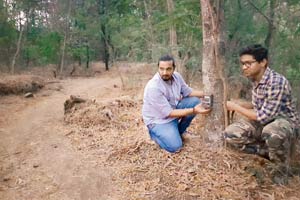In a bid to explain how the big cats reach heavily populated areas in the city, officials have started a camera trapping exercise on the eastern and western peripheries of Sanjay Gandhi National Park, like the ongoing study at Aarey Colony


Nitesh Pancholi, president of TRACK (in blue), and a volunteer install a camera trap
ADVERTISEMENT
Following the success of leopard monitoring at Aarey Milk Colony, the Thane Forest (Territorial) department are starting a similar study on the eastern and western peripheries of the SGNP as well. Thanks to the continues monitoring of leopard activity at Aarey, the Forest Department was able to capture a leopard responsible for man-animal conflict last year.
The areas where the camera trapping study will be conducted include the Mulund-Bhandup-Thane belt (eastern periphery), Thane-Ghodbunder Road, Dahisar-Kandivli, and Malad (western periphery).
Inching closer to the city
The Thane Forest Department (Territorial) wants to keep a tab on the activity of leopards outside protected areas, so it has decided to conduct an intensive camera trapping exercise in various territorial divisions, including Shahpur, Dahanu, Jawhar and Alibaug.
"There have been at least three instances when we rescued leopards from highly populated areas such as Andheri, Ulhasnagar and Mulund. Everyone was surprised by this, because no one knows how the leopard reached these places. A camera trapping exercise outside protected areas, in the jurisdiction of the territorial wings, will give us crucial insight into the behaviour of the elusive big cat.
The data generated via the study will play an important role during man-animal conflict incident, as we will be in a position to zero down on any animal suspected," said Nitesh Pancholi, president of Trust for Rescue, Afforestation, Conservation & Knowledge (TRACK).
Monitoring begins
Using a total of nine flash camera traps and three infrared camera traps provided by Dr Jitendra Ramgaonkar, deputy conservator of forest, the monitoring has begun on the eastern periphery by Santosh Kank, range forest officer of Mumbai range, along with Pancholi and his team of volunteers. They are monitoring leopard activity around Mulund, Bhandup and Thane-Ghodbunder Road.
Mayur Kamath, honorary wildlife warden (HWW) of Mumbai suburbs; Sunish Subramanaian Kunju, HWW of Mumbai city and Pawan Sharma, HWW of Thane will also take part in the camera trapping exercise, so that all areas are covered.
Big cats in the big city
>> March 2018: A leopard was rescued from the densely populated town of Ulhasnagar, far away from the forested patch.
>> January 2018: A leopard had reached Nane Pada area in Mulund East, which is around 4 km away from the forested patch.
>> December 2017: A sub-adult female leopard entered a kindergarten classroom at Sher-E-Punjab Cooperative Housing Society in Andheri.
12
Total no. of camera traps
Also read: Woman survives leopard attack in Bhandara district of Maharashtra
Catch up on all the latest Mumbai news, crime news, current affairs, and also a complete guide on Mumbai from food to things to do and events across the city here. Also download the new mid-day Android and iOS apps to get latest updates
 Subscribe today by clicking the link and stay updated with the latest news!" Click here!
Subscribe today by clicking the link and stay updated with the latest news!" Click here!






